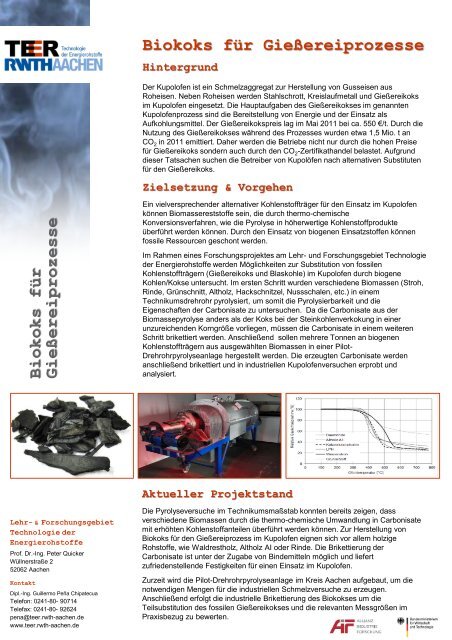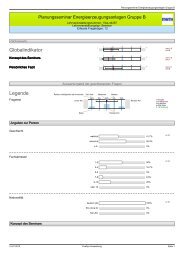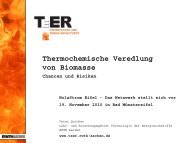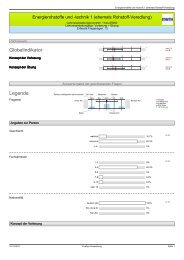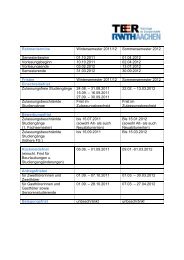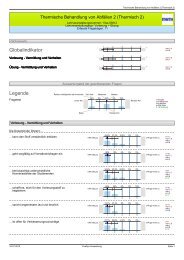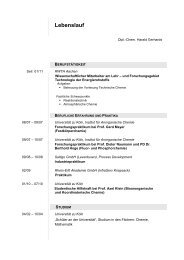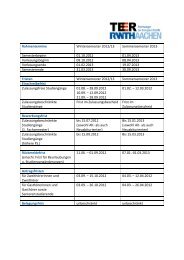Projektflyer - Lehr- und Forschungsgebiet Technologie der ...
Projektflyer - Lehr- und Forschungsgebiet Technologie der ...
Projektflyer - Lehr- und Forschungsgebiet Technologie der ...
Erfolgreiche ePaper selbst erstellen
Machen Sie aus Ihren PDF Publikationen ein blätterbares Flipbook mit unserer einzigartigen Google optimierten e-Paper Software.
Biokoks für<br />
Gießereiprozesse<br />
<strong>Lehr</strong>- & <strong>Forschungsgebiet</strong><br />
<strong>Technologie</strong> <strong>der</strong><br />
Energierohstoffe<br />
Prof. Dr.-Ing. Peter Quicker<br />
Wüllnerstraße 2<br />
52062 Aachen<br />
Kontakt<br />
Dipl.-Ing. Guillermo Peña Chipatecua<br />
Telefon: 0241-80- 90714<br />
Telefax: 0241-80- 92624<br />
pena@teer.rwth-aachen.de<br />
www.teer.rwth-aachen.de<br />
Biokoks für Gießereiprozesse<br />
Hintergr<strong>und</strong><br />
Der Kupolofen ist ein Schmelzaggregat zur Herstellung von Gusseisen aus<br />
Roheisen. Neben Roheisen werden Stahlschrott, Kreislaufmetall <strong>und</strong> Gießereikoks<br />
im Kupolofen eingesetzt. Die Hauptaufgaben des Gießereikokses im genannten<br />
Kupolofenprozess sind die Bereitstellung von Energie <strong>und</strong> <strong>der</strong> Einsatz als<br />
Aufkohlungsmittel. Der Gießereikokspreis lag im Mai 2011 bei ca. 550 €/t. Durch die<br />
Nutzung des Gießereikokses während des Prozesses wurden etwa 1,5 Mio. t an<br />
CO 2 in 2011 emittiert. Daher werden die Betriebe nicht nur durch die hohen Preise<br />
für Gießereikoks son<strong>der</strong>n auch durch den CO 2-Zertifikathandel belastet. Aufgr<strong>und</strong><br />
dieser Tatsachen suchen die Betreiber von Kupolöfen nach alternativen Substituten<br />
für den Gießereikoks.<br />
Zielsetzung & Vorgehen<br />
Ein vielversprechen<strong>der</strong> alternativer Kohlenstoffträger für den Einsatz im Kupolofen<br />
können Biomassereststoffe sein, die durch thermo-chemische<br />
Konversionsverfahren, wie die Pyrolyse in höherwertige Kohlenstoffprodukte<br />
überführt werden können. Durch den Einsatz von biogenen Einsatzstoffen können<br />
fossile Ressourcen geschont werden.<br />
Im Rahmen eines Forschungsprojektes am <strong>Lehr</strong>- <strong>und</strong> <strong>Forschungsgebiet</strong> <strong>Technologie</strong><br />
<strong>der</strong> Energierohstoffe werden Möglichkeiten zur Substitution von fossilen<br />
Kohlenstoffträgern (Gießereikoks <strong>und</strong> Blaskohle) im Kupolofen durch biogene<br />
Kohlen/Kokse untersucht. Im ersten Schritt wurden verschiedene Biomassen (Stroh,<br />
Rinde, Grünschnitt, Altholz, Hackschnitzel, Nussschalen, etc.) in einem<br />
Technikumsdrehrohr pyrolysiert, um somit die Pyrolysierbarkeit <strong>und</strong> die<br />
Eigenschaften <strong>der</strong> Carbonisate zu untersuchen. Da die Carbonisate aus <strong>der</strong><br />
Biomassepyrolyse an<strong>der</strong>s als <strong>der</strong> Koks bei <strong>der</strong> Steinkohlenverkokung in einer<br />
unzureichenden Korngröße vorliegen, müssen die Carbonisate in einem weiteren<br />
Schritt brikettiert werden. Anschließend sollen mehrere Tonnen an biogenen<br />
Kohlenstoffträgern aus ausgewählten Biomassen in einer Pilot-<br />
Drehrohrpyrolyseanlage hergestellt werden. Die erzeugten Carbonisate werden<br />
anschließend brikettiert <strong>und</strong> in industriellen Kupolofenversuchen erprobt <strong>und</strong><br />
analysiert.<br />
Aktueller Projektstand<br />
Die Pyrolyseversuche im Technikumsmaßstab konnten bereits zeigen, dass<br />
verschiedene Biomassen durch die thermo-chemische Umwandlung in Carbonisate<br />
mit erhöhten Kohlenstoffanteilen überführt werden können. Zur Herstellung von<br />
Biokoks für den Gießereiprozess im Kupolofen eignen sich vor allem holzige<br />
Rohstoffe, wie Waldrestholz, Altholz AI o<strong>der</strong> Rinde. Die Brikettierung <strong>der</strong><br />
Carbonisate ist unter <strong>der</strong> Zugabe von Bindemitteln möglich <strong>und</strong> liefert<br />
zufriedenstellende Festigkeiten für einen Einsatz im Kupolofen.<br />
Zurzeit wird die Pilot-Drehrohrpyrolyseanlage im Kreis Aachen aufgebaut, um die<br />
notwendigen Mengen für die industriellen Schmelzversuche zu erzeugen.<br />
Anschließend erfolgt die industrielle Brikettierung des Biokokses um die<br />
Teilsubstitution des fossilen Gießereikokses <strong>und</strong> die relevanten Messgrößen im<br />
Praxisbezug zu bewerten.
Biochar for<br />
Fo<strong>und</strong>ry processes<br />
Unit of<br />
Technology of Fuels<br />
Prof. Dr.-Ing. Peter Quicker<br />
Wüllnerstraße 2<br />
52062 Aachen<br />
Contact<br />
Dipl.-Ing. Guillermo Pena Chipatecua<br />
Phone: +49-241-80- 90714<br />
Fax: +49-241-80- 92624<br />
pena@teer.rwth-aachen.de<br />
www.teer.rwth-aachen.de<br />
Biochar for fo<strong>und</strong>ry processes<br />
Backgro<strong>und</strong><br />
The cupola furnace is a melting furnace for the production of cast iron out of raw<br />
iron. Beside raw iron, there are also steel scrap, recycled metals and fo<strong>und</strong>ry coke<br />
which are used in the cupola furnace. The main tasks of the fo<strong>und</strong>ry coke in the<br />
cupola process are the supply of energy and the use as recarburizer. The price of<br />
fo<strong>und</strong>ry coke was ca. 550 €/t in May 2011. Through the use of fo<strong>und</strong>ry coke for the<br />
process, 1.5 M tons of CO2 were emitted in 2011.Hence, companies are not only<br />
burdened by the high prices of fo<strong>und</strong>ry coke but also by the CO2-certifcat system. As<br />
a result, operators of cupola furnaces are looking for alternative substitutes for<br />
fo<strong>und</strong>ry coke.<br />
Objectives & approach<br />
A promising alternative carbon carrier for the use in a cupola furnace may be<br />
biomass residues, which can be converted into higher class carbon products by<br />
thermo-chemical conversion processes such as pyrolysis. Through the use of<br />
biogenic input material, fossil resources may be saved.<br />
As part of the research project at the Unit of Technology of Fuels, possibilities for the<br />
substitution of fossil carbon carriers (fo<strong>und</strong>ry coke, dust coal) by biogenic<br />
carbon/coke are investigated. In a first step, several biomasses (straw, bark, green<br />
waste, wood residues, nut shells, etc.) shall be pyrolysed in pilot scale rotary kiln to<br />
investigate the pyrolysis capacity and the properties of the obtained carbonization<br />
products. As the carbonization products from the biomass pyrolysis are, other than<br />
coke from hard coal, only available in insufficient grain sizes, the carbonization<br />
products further need to be briquetted to serve as a substitute for fo<strong>und</strong>ry coke.<br />
Subsequently, several tons of biogenic carbon carriers from selected biomasses<br />
shall be produced in a pilot scale rotary kiln. The produced carbonization products<br />
will be briquetted, tested and analyzed in industrial cupola furnace trials.<br />
Project status<br />
The pilot scale pyrolysis tests have already shown that different biomasses can be<br />
converted into carbonization products with higher carbon contents through the<br />
thermo-chemical conversion. For the production of biocoke for the fo<strong>und</strong>ry process,<br />
especially woody residues have proved to be suitable. The briquetting of the<br />
carbonization products is possible with the addition of binding agents and leads to<br />
satisfactory stability of the briquettes for the use in a cupola furnace.<br />
Currently, the pilot rotary kiln pyrolysis plant is set up in the district of Aachen in<br />
or<strong>der</strong> to supply necessary amounts for the industrial melting tests. Subsequently, the<br />
industrial briquetting of the biocoke is carried out to evaluate the partial substitution<br />
of the fossil fo<strong>und</strong>ry coke and the relevant indicators with regard to practical<br />
application.


